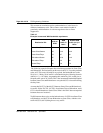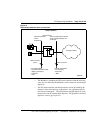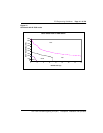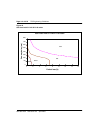
Page 108 of
378
ITG Engineering Guidelines
553-3001-202 Standard 1.00 April 2000
QoS Evaluation Process Overview
There are two main objectives when dealing with the QoS issue in an ITG
network: (1) to predict the expected QoS, (2) to evaluate the QoS after
integrating ITG traffic into the intranet. The process for either case is similar,
one is without ITG traffic and one is with. The fine difference between them
will be discussed at an appropriate place.
In the process, it is assumed that the Ping program is available on a Window
95 or NT PC, or some network management tool which can collect delay and
loss data that is accessed to the T-LAN connecting to the Router going out to
the Intranet:
1 Use ping or equivalent tool to collect round-trip delay (in ms) and loss
(in%) data.
2 Divide the delay by 2 to approximate one-way delay, add 93 ms to adjust
for ITG processing and buffering time.
3 Look up a QoS chart (Figure 5,6,7)
or Table 24 to predict the QoS
categories (excellent, good, fair or poor).
4 If a customer wants to manage the QoS in a more detailed fashion, he/she
can re-balance the values of delay compared to loss by adjusting ITG
system parameters, such as preferred codec, payload size, routing
algorithm, etc. to move resulting QoS among different categories.
5 If the QoS objective is met, repeat the process periodically to make sure
the required QoS is maintained.
Set QoS
The users of corporate voice and data services expect these services to meet
some perceived quality of service (QoS) which in turn influence network
design. The goal is to design and allocate enough resources in the network to
meet users’ needs. QoS metrics or parameters are what quantifies the needs
of the “user” of the "service".
In the context of a Meridian 1 and ITG system, Figure 14 on page 109 shows
the relationship between users and services:
From the diagram it can be seen that there are two interfaces that the
technician needs to consider.


















